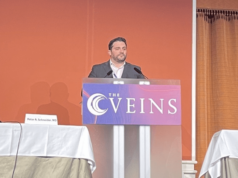
An analysis of post-thrombotic disease patients who received a nitinol stent has found that ultrasound surveillance should occur at frequent intervals up to two weeks post-procedure to predict risk of re-intervention.
The results of the study were presented at the Royal Society of Medicine Venous Forum annual meeting (25–27 June, London, UK) by Adam Gwozdz, clinical research fellow at St Thomas’ Hospital, King’s College London, London, UK.
Gwozdz pointed out that endovenous nitinol stents for the treatment of post-thrombotic syndrome is associated with symptomatic improvement, but that around “40% require re-intervention to maintain stent patency, and maybe duplex ultrasound surveillance is necessary to maintain stent patency. Successful recanlisation depends on early intervention and we know from experience that we are unable to recanalise blocked stents that are more than six weeks old, and therefore early intervention is key,” he said.
The aim of his study, therefore, was to examine whether ultrasound surveillance was sensitive for re-intervention, and whether it was possible to predict which patients had the greatest risk of re-intervention.
To conduct the study, Gwozdz and colleagues at St Thomas’ Hospital included consecutive patients with post-thrombotic disease treated with a nitinol stent between 2012 and 2017. Stent patency was assessed during duplex ultrasonography at 24 hours, two weeks, six weeks, three months, six months, one year and annually after the procedure. Re-interventions were performed when there was a stent diameter reduction of >50% or occlusion.
Of the 194 patients treated, cumulative patency was 86% (median follow-up 2.4 years; range 34–295 weeks). However, Gwozdz et al found that 79 patients required re-intervention to maintain patency, of which 51% (40/79) occurred within three weeks of their procedure. Further, they observed that stenting across the inguinal ligament was associated with a higher risk of early re-intervention.
Highlighting the importance of timely ultrasound surveillance, Gwozdz reported that re-interventions immediately followed ultrasound surveillance in 87% (70/79) of cases, and this was driven by scan results rather than symptom change. At six weeks post-procedure, in-stent stenosis of <30% was a strong predictor of being low risk for re-intervention at six months. Conversely, patients with in-stent stenosis between 30–50% at six weeks were at high risk of requiring re-intervention at six months.
“Taking these results together, our recommendations are that having an ultrasound surveillance programme is an important component of deep venous stenting and that all patients should have surveillance up to two weeks post-procedure. Patients with 0–30% in-stent stenosis at six weeks are at low risk of requiring re-intervention and do not need further surveillance until six months, and patients with 30–50% in-stent stenosis at six weeks are at high-risk of requiring re-intervention and they should have further surveillance at three months,” Gwozdz concluded.












